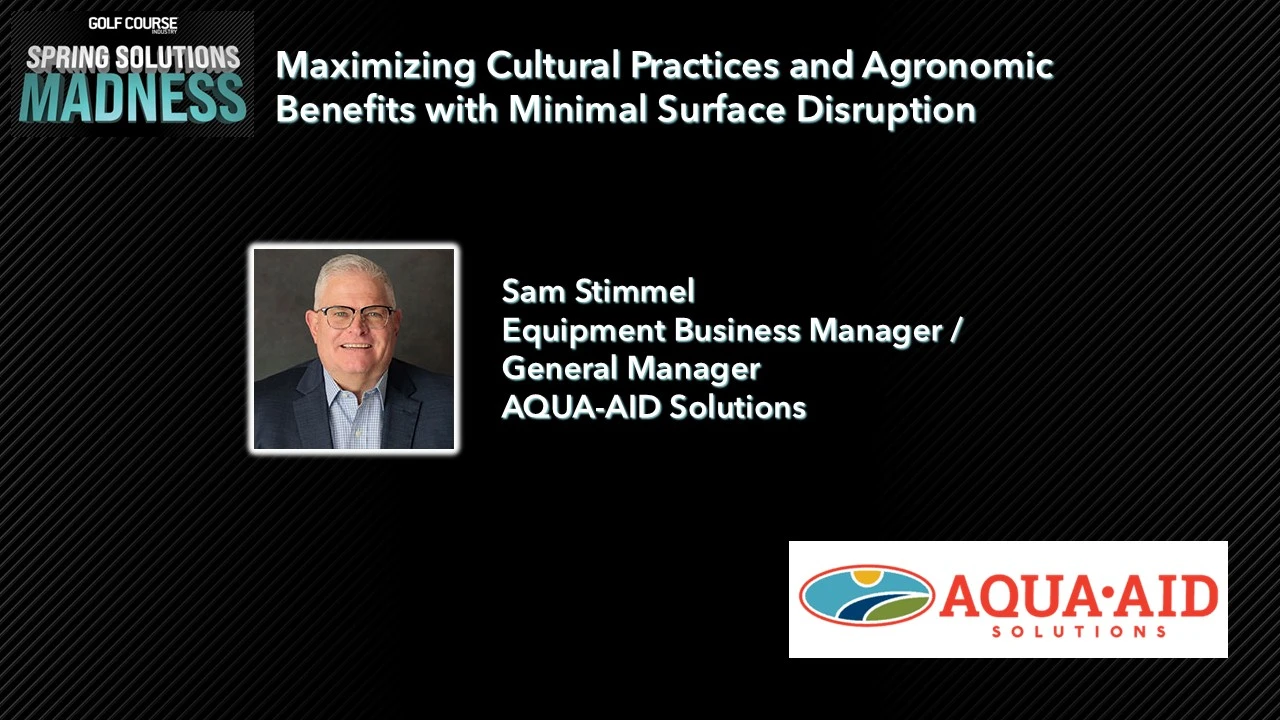Don’t dread drainage design. Instead, simplify the process. Here are some formulas I use to make golf course drainage design easier.
First, here are some basics. Take care of surface drainage problems with surface drainage and subsurface problems with subsurface drainage. Spring correction requires at least four-inch, perforated, gravel-embedded tile drains at the seepage location. However, many superintendents use tile drains to correct surface problems when grading surface pitch of 2 or 3 percent to inlets.
Typically, golf course drainage systems differ from ones used on residential properties. These drainage systems don’t need the large pipes used in subdivisions because engineers size those drains for property protection and the health, safety and welfare of the people who live there. Golf courses usually don’t face such critical safety issues, but an engineer should develop drainage plans where these issues might arise.
Additionally on golf courses, immediate drainage of large storms isn’t necessary or cost effective. Instead, size pipe consistently so the entire course is ready for play. Protect turf conditions from the effects of nuisance drainage and storms by disposing of incidental drainage immediately.
Occasional play delays are acceptable during larger storms while pipe capacity removes storm water. Temporary ponding also helps filter inputs, making smaller pipes and inlets environmentally sound and cost effective.
This is not to diminish the importance of quick drainage, however. Submerged turf suffers from oxygen depletion after only a few hours and dies in as little as two days if submerged during summer temperatures. Drainage systems should handle typical storms in about 90 minutes and drain larger storms in a few days. Draining a storm in 90 minutes is adequate for most golf course installations.
Ensure efficient drainage with a careful plan. After laying out a pipe scheme, use the rational method to size drain pipe. The formula is Q = CIA where:
• Q = runoff (cubic feet per second);
• C = coefficient (percentage of runoff expressed as a decimal);
• I = rainfall intensity rate (inches per hour); and
• A = acres of watershed draining to an inlet.
The mathematically astute will recognize the formula estimates acre-inches per hour. Coincidentally, that’s the same value as cubic feet per second, which is the unit used to size pipe.
To use the rational method, estimate the runoff percentage from a rainfall based on site factors. Some typical coefficient values are: urban/industrial – 70 to 90 percent; residential – 50 to 70 percent; golf course – 30 to 50 percent; and rural – 10 to 30 percent. If parts of the watershed area are urbanized, blend coefficient values based on the portion of drainage area in each land use. Use the higher percentages for clay soils, steep slopes and light turf cover. Use average values for loam soils, moderate slopes and vegetative cover and minimum values for sandy soils, flat slopes and heavy tree cover.
Keep in mind, though, these values are estimates. Some rains will fall on dry soil that will absorb it readily, but other storms will occur when soil is at field capacity from irrigation or earlier rains. Use higher values where possible.
“I” is the amount of water per hour that wants to be drained, which is usually in 90 minutes. In Houston, that’s two inches an hour; in Kansas City, it’s 1.5 inches an hour; and in St. Paul, it’s about one inch an hour. These areas are in the I-35 corridor, which tends to have intense storms. Use these values if at a similar latitude and there’s a safety factor. Assuming 50-percent runoff, the typical Houston drainage acre produces 1 cfs of runoff, Kansas City acres produce 0.75 cfs, and St. Paul acres produce 0.5 cfs.
When sizing catch basins, measure the acreage draining into each inlet and consult the chart below, which is based on typical light-duty golf course basins with a safety factor. Even though smaller inlets might look better, oversize the basins.
Size pipes similarly, starting at the top of the line where the pipe needs the same capacity as the first basin. At subsequent basins, the outlet section of pipe must accommodate that inlet and the water flowing through the pipe.
Overall, pipe size is a function of flow and grade. For example, if the top basin contributes 1 cfs, a 10-inch basin and a six-inch pipe at about 3 percent, or an eight-inch pipe at 0.5 percent is needed. Although smaller pipe costs less, some situations might require larger pipe at a flatter grade. If the next basin adds 4 cfs, that pipe must carry 5 cfs, requiring 10-inch pipe at a 3-percent grade or a 12-inch pipe at a 1-percent grade.
The minimum slopes shown below are those required for self-cleansing velocity. Ignore this and your drainage system will require constant cleaning. The maximum slope limits scoured pipes and exit-area erosion problems from high-flow velocity. The middle range requires some mental gymnastics to arrive at correct pipe size for in-between situations. GCN
Jeff Brauer is a licensed golf course architect and president of GolfScapes, a golf course design firm in Arlington, Texas. Brauer, a past president of the American Society of Golf Course Architects, can be reached at jeff@jeffreydbrauer.com.

Explore the October 2004 Issue
Check out more from this issue and find your next story to read.
Latest from Golf Course Industry
- AQUA-AID Solutions bolsters Sunshine State presence
- Escalante Golf acquires secluded Illinois course
- Tartan Talks 105: Nathan Crace and Todd Quitno
- Disease Discussion 24: Let the turf talk to you
- From the publisher’s pen: Foggy intrigue
- USGA releases Water Conservation Playbook
- Vilamoura Golf courses awarded GEO Certified status
- GCSAA’s Health in Action 5K/2K reaches fundraising goal






